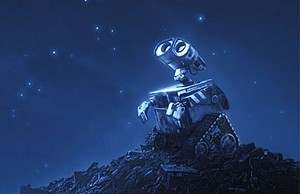Published July 2, 2008 at 5:27 a.m.
Once in a blue moon, a G-rated animation comes along that appeals more to adults than to kids. Pixar’s WALL-E could be one of those exceptions to the rule. True, it features silent-film-inspired slapstick, which knows no target age, and a really cute robot. But to feel the sadness at the core of the movie, it helps to be old enough to remember the heroine of sex, lies and videotape telling her therapist that she obsesses over the fate of the world’s garbage. It helps to be old enough to have bought and discarded major appliances, or to have inherited a deceased person’s boxes of stuff and wondered: Is this all we leave behind?
That’s not a question WALL-E the robot would ask, though he is the inheritor of humanity’s junk all of it. The film starts in both ironic and elegiac mode. As we hear “Put on Your Sunday Clothes” from Hello Dolly a song about rubes eager to go downtown for a big night out the “camera” pans in on Earth from outer space, then plunges through an atmospheric belt of floating trash into a metropolis, or what’s left of one. Above the city’s crumbling skyscrapers tower tidy piles of detritus. Ubiquitous logos for a corporation called Buy ‘N’ Large suggest that we’re looking at what might happen after Wal-Mart took steroids and bought the world.
Besides the cockroaches, the only thing moving in this bleached, smoggy landscape is WALL-E for “Waste Allocation Load Lifter Earth-Class.” Essentially a box with goggle-eyes on a long neck stalk, tank treads for feet and nimble, rodent-like metal paws, WALL-E is still doing what he was programmed to do: gather junk, compress it into cubes, and stack ‘em. The city is littered with the corpses of other WALL-Es who fell down on the job and became trash themselves.
Like the little boy android in Steven Spielberg’s A.I., the last WALL-E has developed needs for beauty and fellowship and, with no other outlets, he’s learned to invest things with emotional value. His den bursts with salvaged fairy lights, oddments, and his prized possession: a videotape of Hello Dolly from which he’s learned about love, Hollywood-style. That knowledge comes in handy when a sleek white robot called EVE lands on Earth. If WALL-E is like a clunky old phonograph that still works, she’s the latest generation of iPod, with her ethereal egg-shaped body and soothing female voice (Elissa Knight). She’s also heavily armed to protect her mission, which she refuses to specify.
The courtship that ensues is nearly wordless. Robots don’t generally talk in this movie: They make sounds that occupy a range somewhere between machines, animal vocalizations and the wonk-wonk of adults in Charlie Brown cartoons. The ingenious mix comes from veteran sound designer Ben Burtt, who created the “voices” of E.T. and R2-D2. Director Andrew Stanton deliberately recreated the look of those old sci-fi films, too: His trashed Earth has so much grit and texture that it’s easy to forget the whole thing was cooked up on someone’s hard drive. When WALL-E follows EVE into space, and we discover what became of humanity, everything gets shallower and shinier. But the movie’s plot works out in a way that allows both its satire and its sentiment to come full circle.
It’s easy to applaud WALL-E’s anti-consumerist message and technical virtuosity, but harder to explain how the little robot puts a lump in adult throats. Pop culture bombards us with cute stuff, from “Lolcat” photos to retro lunchboxes. All of it will end up as junk, of course. WALL-E reminds us that what we seek in “cuteness” is more meaningful: a reminder that people are, deep down, still instinct-driven critters wired to love and survive. Sure, most of us would rather slit our wrists than spend 700 years cleaning up a toxic dumpster, as WALL-E does without complaint. Many of us don’t feel much hope looking at the Earth’s current, greener state, either. But this cartoon gets its power from the notion that some part of us could, would persist in rescuing the things that matter from the mountains of useless stuff.
Info:
- Theaters & Showtimes
- Running Time: 103 min
- Rated: G
More By This Author
Speaking of Movies, movie Review
-

Next Month Brings the Final Curtain for Palace 9 Cinemas
Oct 27, 2023 -

Book Review: 'Save Me a Seat! A Life With Movies,' Rick Winston
Aug 30, 2023 -

Steve MacQueen Named Executive Director of Vermont International Film Festival
May 22, 2023 -

Vermonters Are Going Back to the Movies — Under the Stars
Aug 26, 2020 -

Where to Catch a Movie Near Burlington
Sep 11, 2018 - More »
Comments
Comments are closed.
From 2014-2020, Seven Days allowed readers to comment on all stories posted on our website. While we've appreciated the suggestions and insights, right now Seven Days is prioritizing our core mission — producing high-quality, responsible local journalism — over moderating online debates between readers.
To criticize, correct or praise our reporting, please send us a letter to the editor or send us a tip. We’ll check it out and report the results.
Online comments may return when we have better tech tools for managing them. Thanks for reading.












































